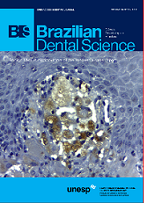Transmigrant impacted mandibular canine: a case report
DOI:
https://doi.org/10.14295/bds.2017.v20i2.1272Resumen
Transmigration of canines across mandibular midline is a rare and elusive phenomenon described in the dental literature. Etiology of this phenomenon is obscure, but in some cases supernumerary teeth may be one of the causes. Surgical extraction is indicated due to pathologic lesions, infection, trauma to the adjacent teeth, pain, ectopic eruption, and interference with prosthesis. The aim of this case report is to describe the treatment of transmigrant impacted mandibular canine near to the mandibular symphysis and to review the literature about its incidence, prevalence, and treatment options. In the anterior mandible, labial access was performed followed by osteotomy and odontosection, for tooth removal. Canine impaction is more prevalent in the maxilla than in the mandible, but canine transmigration is more frequent in the mandible. Females seem to be more affected than males, and the left side is more prevalent than the right. Although the literature is controversial about treatment protocol for transmigrant teeth, several authors indicate its extraction to prevent lesions that are associated with impacted teeth, especially when orthodontic traction is contraindicated due to the position of those teeth.
Descargas
Descargas
Archivos adicionales
Publicado
Cómo citar
Número
Sección
Licencia
Brazilian Dental Science uses the Creative Commons (CC-BY 4.0) license, thus preserving the integrity of articles in an open access environment. The journal allows the author to retain publishing rights without restrictions.
=================
COPYRIGHT TRANSFER AND RESPONSIBILITY STATEMENT
(PDF)
For all articles published in the BDS journal, copyright is retained by the authors. Articles are licensed under an open-access Creative Commons CC BY 4.0 license, meaning that anyone may download and read the paper for free. In addition, the article may be reused and quoted, provided that the original published version is cited. These conditions allow for maximum use and exposure of the work while ensuring that the authors receive proper credit. All metadata associated with published articles is released under the Creative Commons CC0 Universal Public Domain Dedication.
Before the submission, authors must obtain permission to reproduce any published material (figures, schemes, tables, or any extract of a text) that does not fall into the public domain or for which they do not hold the copyright. Permission should be requested by the authors from the copyright holder (usually the Publisher, please refer to the imprint of the individual publications to identify the copyright holder).
The authors hereby attest that the study is original and does not present manipulated data, fraud, or plagiarism. All names listed made a significant scientific contribution to the study, are aware of the presented data, and agree with the final version of the manuscript. They assume complete responsibility for the ethical aspects of the study.
This text must be printed and signed by all authors. The scanned version should be submitted as supplemental file during the submission process.
























